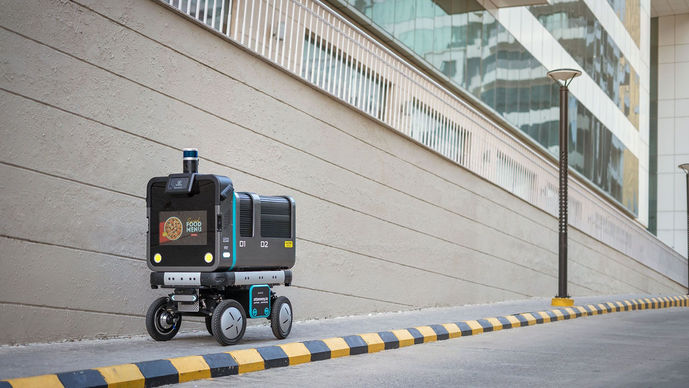FAQs
What is a public-area mobile robot (PMR)?
There are numerous ways of referring to public-area mobile robots including: sidewalk robots, personal delivery devices (PDDs), micro-utility devices (MUDs), etc. For our purposes, a PMR is an unmanned mobile robot — on wheels or legs — that operates at pedestrian speeds in public spaces such as sidewalks, footpaths, bikeways, roadways, malls, airports, hospitals, parks, etc.
Battery-operated and efficient, PMRs might perform one or more tasks such as delivery, maintenance, or security. They can be teleoperated or automated and can be integrated with electric goods vans and secure locker systems. For additional clarity, PMRs do NOT include robots used in industrial, manufacturing or warehouse settings, farming/agricultural robots, aerial drones, electric scooters or e-bikes.
Our blog, “Defining PMRs”, provides a more detailed overview of PMRs in context of ISO 4448.
“Are we doing justice to sidewalk robots?” views PMRs through the lens of emerging legislation in the USA.

What are ISO standards?
The International Organization for Standardization (ISO) is an independent, non-governmental international organization with a membership of 167 national standards bodies. It brings together experts to share knowledge and develop voluntary, consensus-based, market relevant International Standards that support innovation and provide solutions to global challenges. Standards are the distilled wisdom of people with expertise in their subject matter and who know the needs of the organizations they represent – people such as manufacturers, sellers, buyers, customers, trade associations, users or regulators.
At URF, our focus is to develop the ISO TC204 WG19 DTS4448, a global standard that sets the parameters and procedures for "Intelligent transport systems — Public-area Mobile Robots (PMRs) and automated pathway devices". TC204 refers to the ISO Technical Committee that is focused on Intelligent transport systems. WG19 refers to Working Group 19 that is focused on Mobility integration. The convenor of this working group is Knut Evensen. WG19 has 165 people registered representing 21 countries and 4 liaison organisations. Started in December 2018, the group currently has 43 standards in various stages ranging from proposal to publication.
Purpose of WG19:
WG19 will act as a facilitator for Mobility standards development, and equally importantly the harmonization and consensus forming group for Mobility standards in liaison with other ITS standards groups.
The domain of interest for WG19 is:
• Specific mobility integration needs in urban and rural areas, including concepts such as Smart Cities
• Parking and Parking integration
• Standardisation supporting the Public Sector (and other) regulation information sharing needs such as Electronic Traffic Regulations (METR) and controlled zones
• Harmonization of terminology and related architectural aspects that involves mobility issues benefitting from integration across transport sectors (for submission to WG1)
• Governance support for ITS Operations
• Automation integration in the overall transport chain, ranging from micromobility in urban areas, such as Public-area Mobile Robots to coordination of automated road vehicles
• Mobility aspects that are cross-cutting and not covered by any single WG in the ITS domain.

How do PMRs connect with universal accessibility?
In many cities, pedestrian infrastructure is confronting for people with mobility challenges whether blind, deaf, or confined to a wheelchair. PMRs that provide delivery services to members of a local community can be a lifeline for some with disabilities.
As importantly, PMRs share the same infrastructural challenges as do many members of the accessibility community. This common cause is one of the core values of the URF — we argue for improved compliance with national accessibility guidelines as a prerequisite to operating licences in cities.





